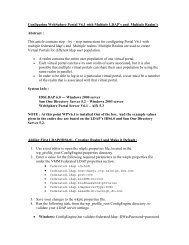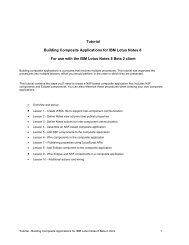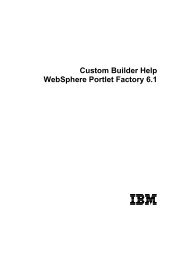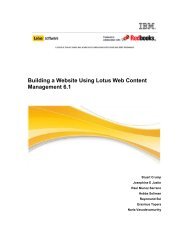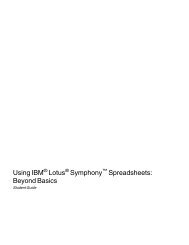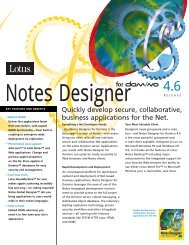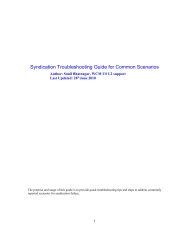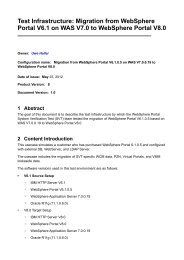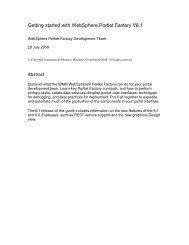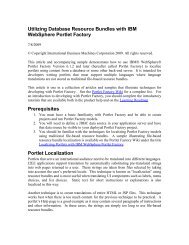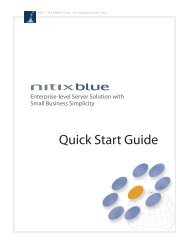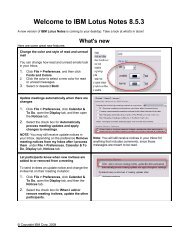You also want an ePaper? Increase the reach of your titles
YUMPU automatically turns print PDFs into web optimized ePapers that Google loves.
If you add a feed for an existing external Atom or RSS feed that includesparameters, the parameters now appear in the registered feed in the catalog. Whenyou add an Atom or RSS feed URL that includes parameters, and click View Feed,a page is displayed in the Feed Editor where you can keep the values of theparameters of the URL that you entered in the Atom or RSS feed field, or you canenter new values for each parameter.The parameters are defined by the external Atom or RSS feed and are delimited byampersand (&) symbols in the URL.New script centralizes <strong>Mashup</strong>Hub objects cache in a cluster environmentThe hubclustercache.py script creates a centralized cache for all <strong>Mashup</strong>Hubobjects shared between nodes in a cluster. A centralized cache provides a consistentview of feed data because the data that is shared between nodes is synchronized.To run the script to centralize the cache, follow these steps:1. Copy the hubclustercache.py file from the <strong>Mashup</strong><strong>Center</strong>_install_root\Config\scripts directory in one of the node installations to the profiles/bindirectory of the WebSphere Application Server (WAS) deployment manager forthe cluster (where <strong>Mashup</strong> <strong>Center</strong> is not installed).2. On the WAS, run the following command:v On Linux: wsadmin -f path_to_script/hubclustercache.py -user username-password passwordv On Windows: wsadmin -f path_to_script\hubclustercache.py -userusername -password passwordOptional: To verify that the script has run successfully, in the WAS Adminconsole on the deployment manager, select Resources → Cache instances →Object cache instances. Only one instance each of <strong>Mashup</strong>Hub feed regioncache and MMMS feed region cache should be displayed. These cacheinstances should have the cluster scope setting in the scope column of thecaches table.Changes to feed objects will be visible immediately on all nodes in the clusterregardless of which node in the cluster handles a user’s request.New formats added to the default set of datetime formatsWhen you cast a feed’s element value to the date data type, <strong>Mashup</strong>Hub convertsthe element’s string value into a datetime type by matching the string format to adefault set of datetime formats. In version 1.0, the mm/dd/yyyy format wassupported. Also, in version 1.0, for Atom feeds, <strong>Mashup</strong>Hub supported thedatetime formats listed in the ISO 8601 specification; and for RSS feeds,<strong>Mashup</strong>Hub supported the datetime formats listed in the RFC 822 and RFC 2822specifications. <strong>Mashup</strong>Hub version 1.1 supports the following changes in the fieldsin the datetime formats:mm/dd/yyyy:v The time component is now supported. Supported fields include minutes,seconds, and a case-insensitive AM/PM flag. All time fields are optional. If theAM/PM flag is present, the time is based on a 12-hour clock. If the AM/PM flagis not present, the time is based on the 24-hour clock. Following are exampledates that <strong>Mashup</strong>Hub will automatically load:– 03/02/08 12:23:54 AM– 3/2/2008 00:23:54What’s new? 9



